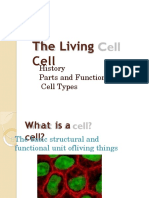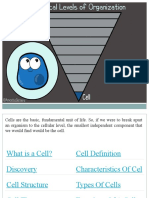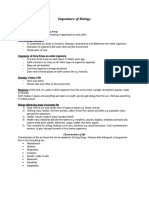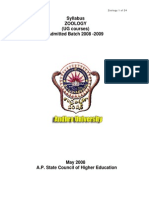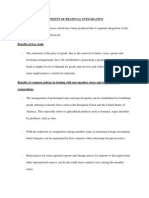Chapter 03 - Cell Structure and Function
Chapter 03 - Cell Structure and Function
Uploaded by
Khadija PrescottCopyright:
Available Formats
Chapter 03 - Cell Structure and Function
Chapter 03 - Cell Structure and Function
Uploaded by
Khadija PrescottOriginal Description:
Copyright
Available Formats
Share this document
Did you find this document useful?
Is this content inappropriate?
Copyright:
Available Formats
Chapter 03 - Cell Structure and Function
Chapter 03 - Cell Structure and Function
Uploaded by
Khadija PrescottCopyright:
Available Formats
Chapter 3 Cell Structure
and Function
CHAPTER 3 Cell Structure and Function
UNIT II LIFE PROCESSES
3.1 The Structure and Function of Plant and
Animal Cells
You should be able to:
draw and label simple diagrams to show the structure
of unspecialised plant and animal cells;
state the functions and explain the importance of
the cell wall, cell membrane, nucleus, chromosomes,
cytoplasm, mitochondria, vacuoles and chloroplast;
and
differentiate between plant and animal cells.
CHAPTER 3 Cell Structure and Function
UNIT II LIFE PROCESSES
3.1 The Structure and Function of Plant and Animal Cells
CHAPTER 3 Cell Structure and Function
UNIT II LIFE PROCESSES
3.1 The Structure and Function of Plant and Animal Cells
CHAPTER 3 Cell Structure and Function
UNIT II LIFE PROCESSES
Structure of Unspecialised Plant and Animal Cell
Animal and plant cells have the following features in common:
Cell membrane
Cytoplasm
Nucleus
Vacuole
Mitochondria
3.1 The Structure and Function of Plant and Animal Cells
CHAPTER 3 Cell Structure and Function
UNIT II LIFE PROCESSES
Differences between plant and animal cells:
3.1 The Structure and Function of Plant and Animal Cells
CHAPTER 3 Cell Structure and Function
UNIT II LIFE PROCESSES
Structure and Function of the Cell and Its Organelles
Cell membrane a cells protective coat
It separates and protects a cell from its surrounding
environment.
It consists of a double layer of phospholipids. Embedded within
are other molecules such as proteins, that act as channels and
pumps to move different molecules into and out of the cell.
It controls the movement of substances into and out of the cell
and is said to be partially permeable.
3.1 The Structure and Function of Plant and Animal Cells
CHAPTER 3 Cell Structure and Function
UNIT II LIFE PROCESSES
Structure and Function of the Cell and Its Organelles
Cytoplasm a cells inner space
It is the watery material between the nucleus and the cell
membrane with a jelly-like consistency.
It contains mainly water and dissolved materials, allowing
materials to move around the cell through a process called
cytoplasmic streaming.
The function of the cytoplasm, and the organelles which reside
in it, are critical for a cells survival.
3.1 The Structure and Function of Plant and Animal Cells
CHAPTER 3 Cell Structure and Function
UNIT II LIFE PROCESSES
Structure and Function of the Cell and Its Organelles
Nucleus a cells centre
It is usually spherical, separated from the cytoplasm by a
double membrane called the nuclear envelope.
It stores deoxyribonucleic acid (DNA), which is wound into
structures called chromatin. DNA is the genetic material of an
organism, carrying instructions for cell activities and heredity.
Its function therefore, is to protect the cells genetic material
and control cell activities. It plays an important role in DNA
replication and protein synthesis (see Chapter 20).
3.1 The Structure and Function of Plant and Animal Cells
CHAPTER 3 Cell Structure and Function
UNIT II LIFE PROCESSES
Structure and Function of the Cell and Its Organelles
Vacuole a cells storage space
In a plant cell, the vacuole is a permanent structure with a fixed
shape, occupying a large central part of the cell. It is
surrounded by a membrane (tonoplast) and contains cell sap, a
solution of mineral salts and sugars.
Plant cells pump a lot of water into the vacuoles which expand
and push against the cell wall. This creates a turgor pressure
which is important to the plant to keep the cells turgid and thus
provide support to the plant (see Chapter 4).
3.1 The Structure and Function of Plant and Animal Cells
CHAPTER 3 Cell Structure and Function
UNIT II LIFE PROCESSES
Structure and Function of the Cell and Its Organelles
Vacuole a cells storage space
In animal cells, the vacuoles are small and scattered throughout
the cytoplasm. They are
temporary structures and are
membrane-bound sacs which have
various functions such as:
transporting materials,
storing sugars,
containing digestive enzymes to digest invading bacteria,
helping the cell to expel excess water.
3.1 The Structure and Function of Plant and Animal Cells
CHAPTER 3 Cell Structure and Function
UNIT II LIFE PROCESSES
Structure and Function of the Cell and Its Organelles
Mitochondria a cells power generator
They are rod shaped and surrounded by a double membrane
with an inner membrane extensively folded. They are sites of
respiration (see Chapter 5) and are responsible for the release
of energy which is subsequently stored in adenosine
triphosphate (ATP) molecules.
Cells which have a high metabolic rate need a constant supply
of energy. These cells, such as muscle and liver cells, contain a
large number of mitochondria.
3.1 The Structure and Function of Plant and Animal Cells
CHAPTER 3 Cell Structure and Function
UNIT II LIFE PROCESSES
Structure and Function of the Cell and Its Organelles
Cell wall a plant cells extra armour
It is found only in plant cells; it is an extra layer of material in
addition to the cell membrane.
Unlike the cell membrane, the cell wall is fully permeable. It is a
rigid structure made up of cellulose and provides strength and
shape to the cell.
It prevents the plant cell from bursting when too much water
enters the vacuole
(see Chapter 4).
3.1 The Structure and Function of Plant and Animal Cells
CHAPTER 3 Cell Structure and Function
UNIT II LIFE PROCESSES
Structure and Function of the Cell and Its Organelles
Chloroplasts a plant cells solar generator
They are similar to mitochondria but are found only in plant
cells which photosynthesise. They are flat discs, surrounded by
a double membrane called the chloroplast envelope.
They are usually green in colour because of a pigment called
chlorophyll. During photosynthesis, chloroplasts trap light
energy from the Sun and energy is stored in ATP (see Chapter
15).
3.1 The Structure and Function of Plant and Animal Cells
CHAPTER 3 Cell Structure and Function
UNIT II LIFE PROCESSES
3.2 Cell Specialisation in Multicellular
Organisms
You should be able to:
explain the importance of cell specialisation; and
differentiate between cell, tissue, organ and organ
system.
CHAPTER 3 Cell Structure and Function
UNIT II LIFE PROCESSES
Cell Specialisation
Multicellular organisms are composed of several
different types of cells; each cell is differently adapted
to perform a specific function.
As the cells are produced and developed, they change
their structure in some ways to specialise in a specific
function.
This process of development is known as cell
differentiation.
3.2 Cell Specialisation in Multicellular Organisms
CHAPTER 3 Cell Structure and Function
UNIT II LIFE PROCESSES
Examples of specialised cells in plants and animals:
Xylem vessels
are pipe-like columns;
provide support;
transport water and mineral salts from roots to other
parts.
3.2 Cell Specialisation in Multicellular Organisms
CHAPTER 3 Cell Structure and Function
UNIT II LIFE PROCESSES
3.2 Cell Specialisation in Multicellular Organisms
Xylem Vessels
CHAPTER 3 Cell Structure and Function
UNIT II LIFE PROCESSES
Examples of specialised cells in plants and animals:
Root hair cell
has a long narrow extension of the cell;
has a large surface area to volume ratio;
increases the rate of
diffusion of water
and mineral salts.
3.2 Cell Specialisation in Multicellular Organisms
CHAPTER 3 Cell Structure and Function
UNIT II LIFE PROCESSES
Examples of specialised cells in plants and animals:
Red blood cells
supply oxygen to other body cells;
contain red pigment called haemoglobin combine
easily with oxygen;
do not have nucleus can pack more haemoglobin;
are biconcave shaped increase surface area;
have an elastic cell membrane allows them to be
squeezed through narrow cap
3.2 Cell Specialisation in Multicellular Organisms
CHAPTER 3 Cell Structure and Function
UNIT II LIFE PROCESSES
Cell Organisation
Some organisms, such as bacteria, are unicellular,
consisting of a single cell. Other organisms, such as
humans, are multicellular, or have many cells an
estimated 100,000,000,000,000 cells!
Multicellular organisms are composed of several
different types of cells organised into organ systems
which work with one another to ensure that the whole
organism functions effectively.
3.2 Cell Specialisation in Multicellular Organisms
CHAPTER 3 Cell Structure and Function
UNIT II LIFE PROCESSES
Cell Organisation
The different levels of organisation are as follows:
1. Similar cells work together as tissues to carry out a
particular function.
3.2 Cell Specialisation in Multicellular Organisms
CHAPTER 3 Cell Structure and Function
UNIT II LIFE PROCESSES
2. Different tissues work together as an organ to carry
out a particular function.
3.2 Cell Specialisation in Multicellular Organisms
CHAPTER 3 Cell Structure and Function
UNIT II LIFE PROCESSES
3. Different organs work together as an organ system to
carry out a particular function.
3.2 Cell Specialisation in Multicellular Organisms
CHAPTER 3 Cell Structure and Function
UNIT II LIFE PROCESSES
4. An organism consists
of several organ
systems with each
carrying out its own
function.
3.2 Cell Specialisation in Multicellular Organisms
CHAPTER 3 Cell Structure and Function
UNIT II LIFE PROCESSES
Other systems include the:
respiratory system,
circulatory system,
nervous system,
digestive system,
excretory system,
musculo skeletal system, and
reproductive system.
3.2 Cell Specialisation in Multicellular Organisms
CHAPTER 3 Cell Structure and Function
UNIT II LIFE PROCESSES
Cell Organisation
Plants are also multicellular organisms.
Epidermal cells make up the epidermal tissue. Xylem
cells and phloem cells make up the vascular tissue.
Many other cells of the cortex and pith make up the
supporting tissue of the stems.
These different plant tissues group together to form
the plant organs the roots, leaves and flowers.
The different organs make up the organ systems of the
plant the roots or shoots system.
3.2 Cell Specialisation in Multicellular Organisms
CHAPTER 3 Cell Structure and Function
UNIT II LIFE PROCESSES
CHAPTER 3 Cell Structure and Function
UNIT II LIFE PROCESSES
Fig 3.20: Plant organs
CHAPTER 3 Cell Structure and Function
UNIT II LIFE PROCESSES
Key Concepts
Cell structure and organelles
All plant and animal cells have a cell membrane made up of
proteins and phospholipids, cytoplasm, a nucleus which
contains deoxyribonucleic acid (DNA) and rod-shaped
structures involved in respiration called mitochondria.
Plant cells are also surrounded by a cell wall which is made up
of cellulose. The cell wall is fully permeable unlike the cell
membrane which is partially permeable. The cell membrane
controls the movement of substances into and out of the cell.
CHAPTER 3 Cell Structure and Function
UNIT II LIFE PROCESSES
Key Concepts
Cell structure and organelles
Plant cells are occupied by a large central vacuole which
contains a solution of salts and sugars called cell sap. This
vacuole is surrounded by a membrane known as the
tonoplast.
Animal cells may also contain vacuoles; however they are
smaller and scattered throughout the cytoplasm.
Chloroplasts are found in plant cells which photosynthesise.
They contain a pigment called chlorophyll.
CHAPTER 3 Cell Structure and Function
UNIT II LIFE PROCESSES
Key Concepts
Cell specialisation and organisation
Cells become specialised in structure to perform a specific
function in a process called cell differentiation.
Similar cells work together as a tissue to carry out a particular
function.
Different tissues work together as an organ to carry out a
particular function.
Different organs work together as an organ system to carry
out a particular function.
A multicellular organism is made up of many organ systems
working together.
You might also like
- Test Bank Stern's Introductory Plant Biology 12th Edition by James BidlackDocument14 pagesTest Bank Stern's Introductory Plant Biology 12th Edition by James Bidlackbachababy0% (2)
- Mitosis Meiosis Music Video ProjectDocument3 pagesMitosis Meiosis Music Video Projectapi-237316144No ratings yet
- Zoology OutlineDocument3 pagesZoology OutlineEj AgsaldaNo ratings yet
- Biological Molecules 1Document29 pagesBiological Molecules 1hamdan.ishaq16No ratings yet
- Support and MovementDocument22 pagesSupport and MovementAzrin MohayaddinNo ratings yet
- Life Chapter 3 From A Cell To An OrganismDocument39 pagesLife Chapter 3 From A Cell To An OrganismvaleNo ratings yet
- Cells Study Guide 2020 KEYDocument4 pagesCells Study Guide 2020 KEYLaarni GeeNo ratings yet
- 11.2 Domain Bacteria and ArchaeaDocument39 pages11.2 Domain Bacteria and ArchaeaZkdlin SpaceNo ratings yet
- AP Biology Chapter 36: Digestive Systems & NutritionDocument24 pagesAP Biology Chapter 36: Digestive Systems & Nutritionderekg608No ratings yet
- HEREDITY AND VARIATION Grade 10Document111 pagesHEREDITY AND VARIATION Grade 10MARVIN COMAYASNo ratings yet
- Respiratory QuotientDocument11 pagesRespiratory QuotientakbarsohailshaikhNo ratings yet
- Eukaryotic Cell Lecture PDFDocument49 pagesEukaryotic Cell Lecture PDFDaezel Deux100% (1)
- Project-Based Learning (PBL) 1 Form Four BiologyDocument4 pagesProject-Based Learning (PBL) 1 Form Four BiologyDewi Salleh100% (1)
- Grade 4 Word Problems Mixed Multiplication Division DDocument3 pagesGrade 4 Word Problems Mixed Multiplication Division DSadiah PratiwiNo ratings yet
- Activity 1Document4 pagesActivity 1sharksiedNo ratings yet
- Endocrine System WorksheetDocument2 pagesEndocrine System WorksheetshasagailNo ratings yet
- CellDocument15 pagesCellprakash kushwahaNo ratings yet
- 2.1.1 WorksheetDocument2 pages2.1.1 Worksheetanumjaved11No ratings yet
- Mitosis and MeiosisDocument32 pagesMitosis and MeiosisManisanthosh Kumar100% (1)
- Cell Division - Key PointsDocument10 pagesCell Division - Key PointssivarajeshwarNo ratings yet
- Answers To Chapter 7 ExercisesDocument2 pagesAnswers To Chapter 7 ExercisessAnDrA SaNdWiChNo ratings yet
- Microbial DiversityDocument6 pagesMicrobial DiversityDev AnandhNo ratings yet
- Summary Notes - Topic 2 Organisation of The Organism - CAIE Biology IGCSEDocument3 pagesSummary Notes - Topic 2 Organisation of The Organism - CAIE Biology IGCSEAiko KameishiNo ratings yet
- Cells As The Basis of Life 1Document40 pagesCells As The Basis of Life 1Singh Gurleen100% (1)
- Chapter8-Support & MovementDocument30 pagesChapter8-Support & MovementNisa TaniesaNo ratings yet
- Lesson 1 Cellular Processes PPTDocument19 pagesLesson 1 Cellular Processes PPTkj47ynpdh7No ratings yet
- 2.4.1 Cell WallDocument17 pages2.4.1 Cell WallSyahirah SyerryNo ratings yet
- Cell Biology Handout - 1Document62 pagesCell Biology Handout - 1Dewi Lasimpara100% (1)
- 1.importance of BiologyDocument5 pages1.importance of BiologyZahra AliNo ratings yet
- Enzyme: Ns. Shila Wisnasari, S.Kep., M.BiomedDocument55 pagesEnzyme: Ns. Shila Wisnasari, S.Kep., M.BiomedSyahdaJuvenilProfitamelaNo ratings yet
- Cell Structure FunctionDocument26 pagesCell Structure Functionveeramani0% (1)
- Characteristics of Living Things Lecture NotesDocument12 pagesCharacteristics of Living Things Lecture NotesErica HartNo ratings yet
- Cell DivisionDocument48 pagesCell DivisionMichaelNo ratings yet
- 4 Cell Membranes and TransportDocument3 pages4 Cell Membranes and TransportTala AlkhawajaNo ratings yet
- Human Reproductive System: Nurturing Innovative Teachers and Education LeadersDocument25 pagesHuman Reproductive System: Nurturing Innovative Teachers and Education LeadersPhoeberly Sabado100% (1)
- 6 Kingdoms of Life Lecture NotesDocument82 pages6 Kingdoms of Life Lecture NotesEvangelene Esquillo SanaNo ratings yet
- Support and MovementDocument28 pagesSupport and MovementDayangNo ratings yet
- Unit 2 DiversityDocument65 pagesUnit 2 DiversityNermine AbedNo ratings yet
- Active and Passive Transport RhsDocument25 pagesActive and Passive Transport Rhswaqas_xsNo ratings yet
- ZoologyDocument24 pagesZoologyS V S VardhanNo ratings yet
- Cell Organelles WorksheetDocument7 pagesCell Organelles WorksheetKenneth ParungaoNo ratings yet
- Chemical Composition of CellDocument18 pagesChemical Composition of CellRajananthini PushpanathanNo ratings yet
- Diffusion and Osmosis ExperimentDocument3 pagesDiffusion and Osmosis ExperimentstjustinsNo ratings yet
- Cmb-Ppt-5-Endoplasmic Reticulum-Borja, Jayven CDocument11 pagesCmb-Ppt-5-Endoplasmic Reticulum-Borja, Jayven CJboar TbenecdiNo ratings yet
- Cell Structure and FunctionDocument8 pagesCell Structure and FunctionTshibambeNo ratings yet
- Lecture Note Plant Structure and FunctionDocument22 pagesLecture Note Plant Structure and FunctionMilka Rahman100% (1)
- Microbial Taxonomy and DiversityDocument7 pagesMicrobial Taxonomy and DiversitySabbir ShuvoNo ratings yet
- Gene Expression in Prokaryotes.Document23 pagesGene Expression in Prokaryotes.M.PRASAD NAIDU100% (1)
- Types of TransportDocument31 pagesTypes of Transportprateek gangwaniNo ratings yet
- Summary Cell Structures and FunctionsDocument5 pagesSummary Cell Structures and FunctionsJoseph FuentesNo ratings yet
- MitosisDocument32 pagesMitosisapi-295864428No ratings yet
- Excretory System CiegoDocument2 pagesExcretory System CiegoMagui Jambrina Martín100% (1)
- Introduction To Developmental BiologyDocument32 pagesIntroduction To Developmental BiologyJovie Esquivias NicolasNo ratings yet
- Membrane TransportDocument24 pagesMembrane Transportolawandeilo123No ratings yet
- WAEC Biology2 November 2011Document15 pagesWAEC Biology2 November 2011Oyasor Ikhapo AnthonyNo ratings yet
- Human KaryotypeDocument10 pagesHuman Karyotypeprism1702No ratings yet
- Protein Chemistry Section ExamDocument9 pagesProtein Chemistry Section ExamJoelNo ratings yet
- BiologyDocument76 pagesBiologycabdifataxNo ratings yet
- Mycobacteria: Molecular Biology and VirulenceFrom EverandMycobacteria: Molecular Biology and VirulenceC. RatledgeNo ratings yet
- Regional Integration in The CaribbeanDocument4 pagesRegional Integration in The CaribbeanKhadija Prescott100% (1)
- Meiosis NotesDocument1 pageMeiosis NotesKhadija PrescottNo ratings yet
- Ionisation EnergyDocument4 pagesIonisation EnergyKhadija PrescottNo ratings yet
- Biology Is The Study of All Forms of Life.: Key ConceptDocument9 pagesBiology Is The Study of All Forms of Life.: Key ConceptKhadija PrescottNo ratings yet
- Ephesians GalatiansDocument2 pagesEphesians GalatiansKhadija PrescottNo ratings yet
- Chapter 01 - Diversity of LifeDocument27 pagesChapter 01 - Diversity of LifeMaryam AliNo ratings yet
- Chemistry Unit2 Paper2 May 2010Document9 pagesChemistry Unit2 Paper2 May 2010dela2100% (1)
- Meiosis Pop BeadsDocument6 pagesMeiosis Pop BeadsKhadija PrescottNo ratings yet
- Modeling MeiosisDocument3 pagesModeling MeiosisKhadija PrescottNo ratings yet
- HIV ScienceDocument2 pagesHIV ScienceKhadija PrescottNo ratings yet
- Benefits of Regional Integration (L)Document4 pagesBenefits of Regional Integration (L)Khadija Prescott75% (4)
- Biology Practise Questions Unit 1 Module 2Document16 pagesBiology Practise Questions Unit 1 Module 2ashtigosineNo ratings yet
- Mls 2201 Group ADocument16 pagesMls 2201 Group ANeyo ThomasNo ratings yet
- L 1 Introduction and Types of ImmunityDocument13 pagesL 1 Introduction and Types of ImmunityaugustongoviNo ratings yet
- Reporting ScripttDocument4 pagesReporting Scripttnicole besarioNo ratings yet
- Electron Transport ChainDocument3 pagesElectron Transport ChainEmma MelNo ratings yet
- Biology ReviewerDocument12 pagesBiology ReviewerAngela SernatNo ratings yet
- 2 Replikasi DNADocument26 pages2 Replikasi DNAAngga WipraNo ratings yet
- Biology Term 1 Revision WS Yr 9Document5 pagesBiology Term 1 Revision WS Yr 9Alina Vinay SivaNo ratings yet
- Henderson 2021Document62 pagesHenderson 2021David ValtierrezNo ratings yet
- Enzymes PresDocument34 pagesEnzymes PresRasmia SalamNo ratings yet
- Medicinal Chemistry: Lectures Note 8Document10 pagesMedicinal Chemistry: Lectures Note 8nosaybaNo ratings yet
- Lab 4 Drawing of A Cross Section of A Ligustrum Plant Cell Under A Light MicroscopeDocument4 pagesLab 4 Drawing of A Cross Section of A Ligustrum Plant Cell Under A Light MicroscopeMichael TimsonNo ratings yet
- MBBS Teaching Schedule October 2023 Batch 2023-24Document1 pageMBBS Teaching Schedule October 2023 Batch 2023-24Krushnaraj sinhNo ratings yet
- A2 Biology Unit 4 Mark SchemesDocument37 pagesA2 Biology Unit 4 Mark SchemesMasthankhan PatanNo ratings yet
- Bacteria: Cell Walls: Structure of PeptidoglycanDocument14 pagesBacteria: Cell Walls: Structure of PeptidoglycanReese SoleilNo ratings yet
- ExcerptDocument10 pagesExcerptChristina PatrNo ratings yet
- Cell Scenarios10Document2 pagesCell Scenarios10bobbie66No ratings yet
- ANA Patterns EuroimmuneDocument4 pagesANA Patterns EuroimmuneManuel ArenasNo ratings yet
- Worksheet - 1 CellDocument1 pageWorksheet - 1 CellknlsinhaNo ratings yet
- Core Course 1: Principles of Genetics: Lecture Manual inDocument61 pagesCore Course 1: Principles of Genetics: Lecture Manual inJeremy AngeloNo ratings yet
- 5.1 MitosisDocument18 pages5.1 MitosiszulkarnainNo ratings yet
- The Living CellsDocument44 pagesThe Living CellsmariacervantesfNo ratings yet
- 1.1 Introduction To Cells Skeleton NotesDocument15 pages1.1 Introduction To Cells Skeleton Notesadri baigorriNo ratings yet
- 5 Stages of FastingDocument7 pages5 Stages of FastingMahdi100% (1)
- Hematology Slides Step 1 UsmleDocument1 pageHematology Slides Step 1 Usmlenreena aslamNo ratings yet
- Lymphatic System N Body DefenseDocument23 pagesLymphatic System N Body Defensehafiz amriNo ratings yet
- Cell Transport Is Movement of Materials Across Cell Membranes It IncludesDocument3 pagesCell Transport Is Movement of Materials Across Cell Membranes It IncludesSheshira Reddy YeruvaNo ratings yet
- GluconeogenesisDocument31 pagesGluconeogenesisRajakannan100% (3)
- Genome Analysis Multiple Choice Question (GuruKpo)Document14 pagesGenome Analysis Multiple Choice Question (GuruKpo)GuruKPO93% (15)














